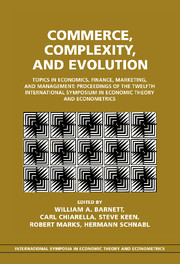 Commerce, Complexity, and Evolution
Commerce, Complexity, and Evolution Book contents
- Frontmatter
- Contents
- Series editor's preface
- Volume editors' preface
- Editors
- List of contributors
- I Philosophical and methodological implications of complexity and evolution in economic systems
- II Finance and the macroeconomy
- 5 The nonlinear economics of debt deflation
- 6 The emergence of complex dynamics in a “naturally” nonlinear integrated Keynesian model of monetary growth
- 7 Stochastic volatility in interest rates and complex dynamics in velocity
- 8 A genetic-programming-based approach to the generation of foreign-exchange trading models
- 9 Hybrid option pricing with an optimal weighted implied standard deviation
- III Market and sectoral dynamics
- IV Marketing and interdependent behavior
8 - A genetic-programming-based approach to the generation of foreign-exchange trading models
Published online by Cambridge University Press: 05 December 2011
- Frontmatter
- Contents
- Series editor's preface
- Volume editors' preface
- Editors
- List of contributors
- I Philosophical and methodological implications of complexity and evolution in economic systems
- II Finance and the macroeconomy
- 5 The nonlinear economics of debt deflation
- 6 The emergence of complex dynamics in a “naturally” nonlinear integrated Keynesian model of monetary growth
- 7 Stochastic volatility in interest rates and complex dynamics in velocity
- 8 A genetic-programming-based approach to the generation of foreign-exchange trading models
- 9 Hybrid option pricing with an optimal weighted implied standard deviation
- III Market and sectoral dynamics
- IV Marketing and interdependent behavior
Summary
Of all the markets available to the international investor, the global foreign-exchange markets are perhaps the most liquid and heavily traded. The average daily turnover in currencies around the world is estimated to be up to a trillion dollars a day.
Currency markets show myriad different behavior patterns, with quiet periods, intervals of extreme volatility, steady trends, violent reactions to external news events, and positive feedback all seen at various times. Despite the apparent unpredictability of these markets, it is estimated that at least 90% of the turnover in foreign exchange is due to speculative interbank trading by large financial institutions attempting to make short-term returns.
Pressure on capital ratios within the banking sector has led to the investigation of new ways of taking on risk by trading markets in a rigorously controlled manner. As a part of such a strategy, the rest of this chapter describes a class of algorithms to assist in the determination of market direction. However, we stress that directional trading algorithms are only part of a successful investment operation. Equal weight must be given to asset allocation and risk management.
The majority of algorithmic trading systems are those in which a computer program gives directional forecasts for markets, based on recent market activity. Such models are frequently specified in terms of technical indicators or mathematical functions that compress information about an aspect of recent market behavior into a single number. These indicators are then combined into simple rules and used for trading purposes. Sample indicators include moving averages, overbought and oversold indicators, and historical volatilities.
- Type
- Chapter
- Information
- Commerce, Complexity, and EvolutionTopics in Economics, Finance, Marketing, and Management: Proceedings of the Twelfth International Symposium in Economic Theory and Econometrics, pp. 173 - 190Publisher: Cambridge University PressPrint publication year: 2000
- 1
- Cited by


